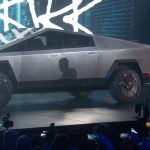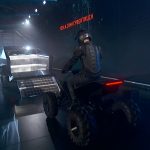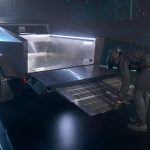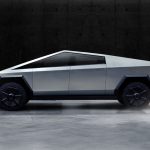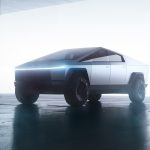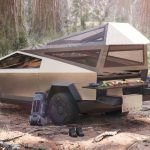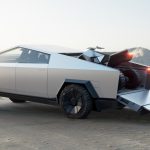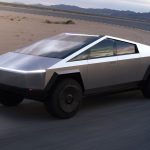
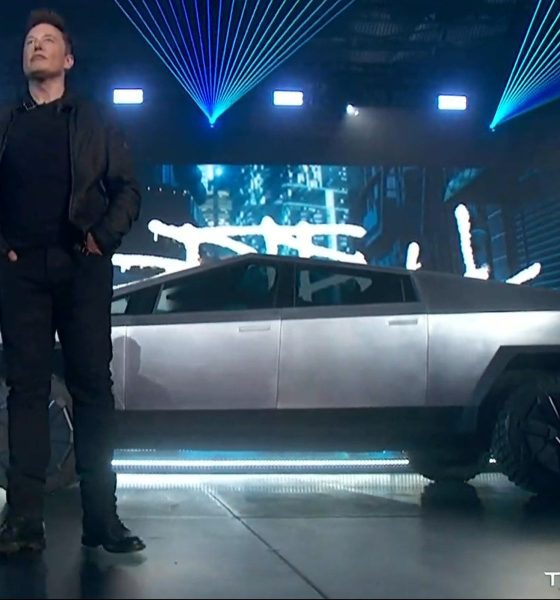
News
Tesla Cybertruck pickup: ultra hard stainless steel, 0-60 in 2.9 secs, 14k lbs towing capacity, and $40k base price
Tesla has revealed its highly-anticipated pickup truck to the public, and it is every bit the monster that CEO Elon Musk has made it out to be. With its aggressive stance, high ground clearance, and massive frame, the Tesla’s CYBRTRK is quite a sight to behold. It also shows that while Tesla has pretty much created stunning city cars until today, the company is every bit as capable of creating a daunting machine that can perform just as well on paved roads as it does on rough terrain.
Design
The Tesla Cybertruck does not look like a traditional pickup. True to Elon Musk’s words, the vehicle does look like a futuristic armored personnel carrier that stepped out of the set of Blade Runner. Its straight sloping roof give the pickup a streamlined yet very unique look. As the Tesla CEO has stated in the past, the Cybertruck won’t look like any other pickup on the road today.
That being said, there are several key design aspects that are notable about the Cybertruck. These include its extremely angular body, its large bed, and its high ground clearance. The Cybertruck also has a thick stainless steel body, which Tesla demonstrated by having a sledgehammer hit the pickup’s door panel. The vehicle is also fitted with Tesla’s Armor Glass, which unfortunately cracked after a large steel ball was thrown at it onstage. The metal ball didn’t go through the glass though, which is a plus.
- Credit: Tesla/YouTube
- (Credit: Tesla)
Specs
Tesla has pretty much mastered the art of keeping the specs of its upcoming vehicles’ secret. As it turns out, the Cybertruck’s performance figures are definitely worth the secrecy, as they are flat-out insane. The vehicle is equipped with a standard single motor and can be upgraded to dual and tri-motors. Just as Musk said, the Cybertruck, despite its size, is quite nimble, thanks to its instant torque and adaptive air suspension that can adjust height to meet the vehicle’s intended purpose. These ultimately allow the Cybertruck to hit 60 mph in just 2.9 seconds, with handling comparable to a Porsche.
Here are other notable specs of the Tesla Cybertruck:
- 250+, 300+, and 500+ miles of range
- 3500 lbs payload
- Towing rating between 7.5k to 14k lbs
- 250 kW charging
- Off-road performance with 35 degrees approach angle, up to 16″ clearance, and 28 degrees departure angle
- 100 cubic feet of exterior storage
- The Cybertruck’s overlanding capabilities as teased by Tesla. (Credit: Tesla)
- (Credit: Tesla)
- Credit: Tesla
Special Features
Pickups are utility vehicles by nature, and as such, they are used primarily for work on locations such as farms or construction sites. Luxury pickups exist that prioritize comfort over utility, but Tesla’s monster pickup has chosen to do both. The interior of the Cybertruck is classic Tesla in the way that it’s minimalist and airy, with plush seats and a massive touchscreen that’s optimized for work and even entertainment. This, however, is only the tip of the iceberg when it comes to the pickup truck’s notable features. Others include:
- 110v/220v onboard outlets
- Full Self-Driving features
- Autopilot as standard
Price
Earlier this year, Elon Musk has mentioned that the Tesla Cybertruck would start at $49,000 at the highest. Tesla has stayed true to its CEO’s words, pricing the futuristic pickup truck very aggressively compared to other EV trucks and ICE-powered luxury pickups. Tesla’s Cybertruck does have a number of higher-priced trims, and these cost substantially more, while offering significantly more.
Here’s the complete pricing of Tesla’s Cybertruck depending on its trim.
- Single Motor RWD – $39,900 before options
- Dual Motor AWD – $49,900 before options
- Tri-Motor AWD – $69,900 before options

Elon Musk
Elon Musk and Tesla AI Director share insights after empty driver seat Robotaxi rides
The executives’ unoccupied tests hint at the rapid progress of Tesla’s unsupervised Robotaxi efforts.

Tesla CEO Elon Musk and AI Director Ashok Elluswamy celebrated Christmas Eve by sharing personal experiences with Robotaxi vehicles that had no safety monitor or occupant in the driver’s seat. Musk described the system’s “perfect driving” around Austin, while Elluswamy posted video from the back seat, calling it “an amazing experience.”
The executives’ unoccupied tests hint at the rapid progress of Tesla’s unsupervised Robotaxi efforts.
Elon and Ashok’s firsthand Robotaxi insights
Prior to Musk and the Tesla AI Director’s posts, sightings of unmanned Teslas navigating public roads were widely shared on social media. One such vehicle was spotted in Austin, Texas, which Elon Musk acknowleged by stating that “Testing is underway with no occupants in the car.”
Based on his Christmas Eve post, Musk seemed to have tested an unmanned Tesla himself. “A Tesla with no safety monitor in the car and me sitting in the passenger seat took me all around Austin on Sunday with perfect driving,” Musk wrote in his post.
Elluswamy responded with a 2-minute video showing himself in the rear of an unmanned Tesla. The video featured the vehicle’s empty front seats, as well as its smooth handling through real-world traffic. He captioned his video with the words, “It’s an amazing experience!”
Towards Unsupervised operations
During an xAI Hackathon earlier this month, Elon Musk mentioned that Tesla owed be removing Safety Monitors from its Robotaxis in Austin in just three weeks. “Unsupervised is pretty much solved at this point. So there will be Tesla Robotaxis operating in Austin with no one in them. Not even anyone in the passenger seat in about three weeks,” he said. Musk echoed similar estimates at the 2025 Annual Shareholder Meeting and the Q3 2025 earnings call.
Considering the insights that were posted Musk and Elluswamy, it does appear that Tesla is working hard towards operating its Robotaxis with no safety monitors. This is quite impressive considering that the service was launched just earlier this year.
Elon Musk
Starlink passes 9 million active customers just weeks after hitting 8 million
The milestone highlights the accelerating growth of Starlink, which has now been adding over 20,000 new users per day.

SpaceX’s Starlink satellite internet service has continued its rapid global expansion, surpassing 9 million active customers just weeks after crossing the 8 million mark.
The milestone highlights the accelerating growth of Starlink, which has now been adding over 20,000 new users per day.
9 million customers
In a post on X, SpaceX stated that Starlink now serves over 9 million active users across 155 countries, territories, and markets. The company reached 8 million customers in early November, meaning it added roughly 1 million subscribers in under seven weeks, or about 21,275 new users on average per day.
“Starlink is connecting more than 9M active customers with high-speed internet across 155 countries, territories, and many other markets,” Starlink wrote in a post on its official X account. SpaceX President Gwynne Shotwell also celebrated the milestone on X. “A huge thank you to all of our customers and congrats to the Starlink team for such an incredible product,” she wrote.
That growth rate reflects both rising demand for broadband in underserved regions and Starlink’s expanding satellite constellation, which now includes more than 9,000 low-Earth-orbit satellites designed to deliver high-speed, low-latency internet worldwide.
Starlink’s momentum
Starlink’s momentum has been building up. SpaceX reported 4.6 million Starlink customers in December 2024, followed by 7 million by August 2025, and 8 million customers in November. Independent data also suggests Starlink usage is rising sharply, with Cloudflare reporting that global web traffic from Starlink users more than doubled in 2025, as noted in an Insider report.
Starlink’s momentum is increasingly tied to SpaceX’s broader financial outlook. Elon Musk has said the satellite network is “by far” the company’s largest revenue driver, and reports suggest SpaceX may be positioning itself for an initial public offering as soon as next year, with valuations estimated as high as $1.5 trillion. Musk has also suggested in the past that Starlink could have its own IPO in the future.
News
NVIDIA Director of Robotics: Tesla FSD v14 is the first AI to pass the “Physical Turing Test”
After testing FSD v14, Fan stated that his experience with FSD felt magical at first, but it soon started to feel like a routine.

NVIDIA Director of Robotics Jim Fan has praised Tesla’s Full Self-Driving (Supervised) v14 as the first AI to pass what he described as a “Physical Turing Test.”
After testing FSD v14, Fan stated that his experience with FSD felt magical at first, but it soon started to feel like a routine. And just like smartphones today, removing it now would “actively hurt.”
Jim Fan’s hands-on FSD v14 impressions
Fan, a leading researcher in embodied AI who is currently solving Physical AI at NVIDIA and spearheading the company’s Project GR00T initiative, noted that he actually was late to the Tesla game. He was, however, one of the first to try out FSD v14.
“I was very late to own a Tesla but among the earliest to try out FSD v14. It’s perhaps the first time I experience an AI that passes the Physical Turing Test: after a long day at work, you press a button, lay back, and couldn’t tell if a neural net or a human drove you home,” Fan wrote in a post on X.
Fan added: “Despite knowing exactly how robot learning works, I still find it magical watching the steering wheel turn by itself. First it feels surreal, next it becomes routine. Then, like the smartphone, taking it away actively hurts. This is how humanity gets rewired and glued to god-like technologies.”
The Physical Turing Test
The original Turing Test was conceived by Alan Turing in 1950, and it was aimed at determining if a machine could exhibit behavior that is equivalent to or indistinguishable from a human. By focusing on text-based conversations, the original Turing Test set a high bar for natural language processing and machine learning.
This test has been passed by today’s large language models. However, the capability to converse in a humanlike manner is a completely different challenge from performing real-world problem-solving or physical interactions. Thus, Fan introduced the Physical Turing Test, which challenges AI systems to demonstrate intelligence through physical actions.
Based on Fan’s comments, Tesla has demonstrated these intelligent physical actions with FSD v14. Elon Musk agreed with the NVIDIA executive, stating in a post on X that with FSD v14, “you can sense the sentience maturing.” Musk also praised Tesla AI, calling it the best “real-world AI” today.

